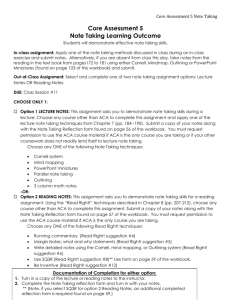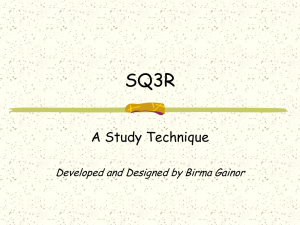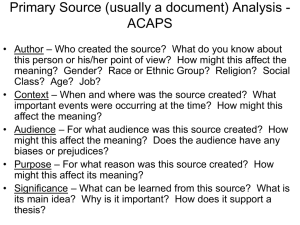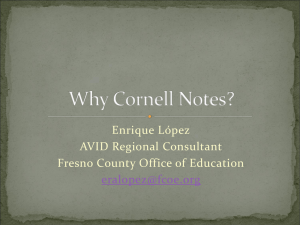outlines elaborate
advertisement
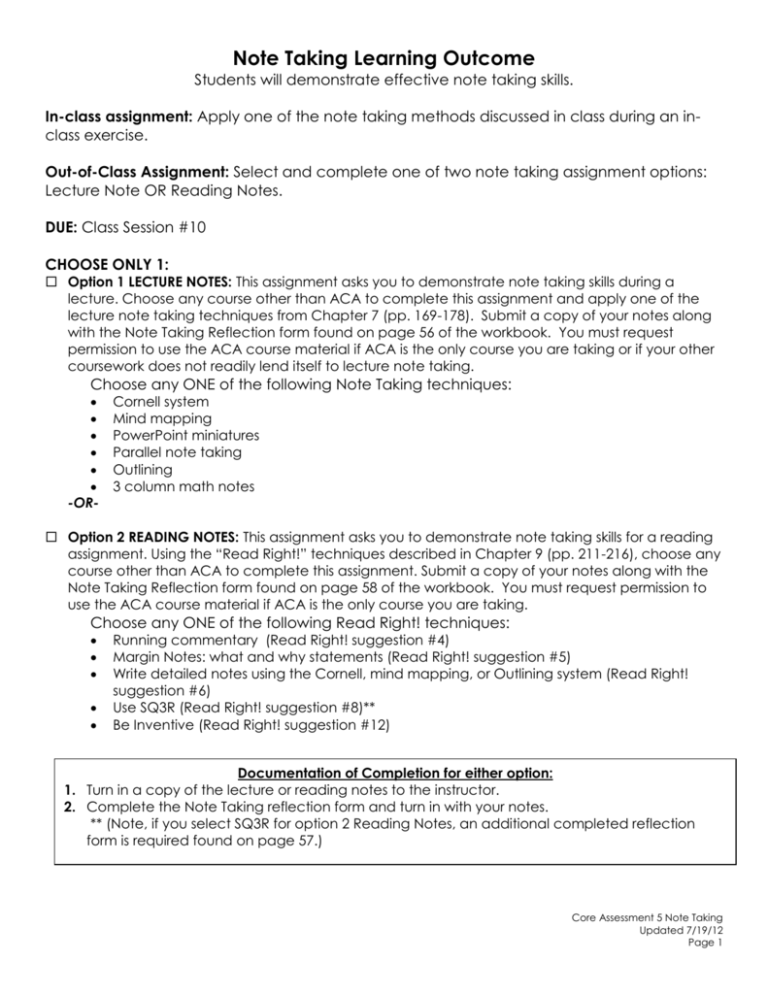
Note Taking Learning Outcome Students will demonstrate effective note taking skills. In-class assignment: Apply one of the note taking methods discussed in class during an inclass exercise. Out-of-Class Assignment: Select and complete one of two note taking assignment options: Lecture Note OR Reading Notes. DUE: Class Session #10 CHOOSE ONLY 1: Option 1 LECTURE NOTES: This assignment asks you to demonstrate note taking skills during a lecture. Choose any course other than ACA to complete this assignment and apply one of the lecture note taking techniques from Chapter 7 (pp. 169-178). Submit a copy of your notes along with the Note Taking Reflection form found on page 56 of the workbook. You must request permission to use the ACA course material if ACA is the only course you are taking or if your other coursework does not readily lend itself to lecture note taking. Choose any ONE of the following Note Taking techniques: -OR- Cornell system Mind mapping PowerPoint miniatures Parallel note taking Outlining 3 column math notes Option 2 READING NOTES: This assignment asks you to demonstrate note taking skills for a reading assignment. Using the “Read Right!” techniques described in Chapter 9 (pp. 211-216), choose any course other than ACA to complete this assignment. Submit a copy of your notes along with the Note Taking Reflection form found on page 58 of the workbook. You must request permission to use the ACA course material if ACA is the only course you are taking. Choose any ONE of the following Read Right! techniques: Running commentary (Read Right! suggestion #4) Margin Notes: what and why statements (Read Right! suggestion #5) Write detailed notes using the Cornell, mind mapping, or Outlining system (Read Right! suggestion #6) Use SQ3R (Read Right! suggestion #8)** Be Inventive (Read Right! suggestion #12) Documentation of Completion for either option: 1. Turn in a copy of the lecture or reading notes to the instructor. 2. Complete the Note Taking reflection form and turn in with your notes. ** (Note, if you select SQ3R for option 2 Reading Notes, an additional completed reflection form is required found on page 57.) Core Assessment 5 Note Taking Updated 7/19/12 Page 1 Note Taking Reflection Form- Page 1 of 2 Directions: After completion of Note Taking Core Assessment 5, answer the following in full sentences and in detail. The assignment will be graded based on the level of detail in your responses. Attach a copy of your notes. If you use margin notes, you may photocopy a sample of pages from your text or re-write the notes, indicating the page and paragraph beside which you placed the notes. Name: 1. Which note taking assignment option did you complete? Option 1 LECTURE NOTES If Option 1, which technique did you use? Cornell system Mind mapping PowerPoint miniatures Parallel note taking Outlining Three-column math notes Option 2 READING NOTES If Option 2, which technique did you use? Running commentary Margin notes Write detailed notes: Used Cornell system for detailed notes Used Mind mapping for detailed notes Used Outlining for detailed notes SQ3R (COMPLETE ADDITIONAL SQ3R Reflection form) Be inventive Describe inventive strategy: 2. In which course did you take lecture or reading notes? What topic was being discussed? OPTION 1 LECTURE NOTES OPTION 2 READING NOTES Course name and number: Course name and number: Instructor’s name: Title of the textbook: Date of lecture: Chapter title: Time of class: Page numbers: Topic of discussion: Reflection continues to second page Core Assessment 5 Note Taking Updated 7/19/12 Page 2 Note Taking Reflection Form- Page 2 of 2 3. From your perspective, what are the positives of this method? If you did not find any positives, elaborate on why. 4. From your perspective, what negatives did you encounter? If you did not find any negatives, elaborate on why. 5. Will you use this lecture or reading note taking method again? Why or why not? Core Assessment 5 Note Taking Updated 7/19/12 Page 3 SQ3R Documentation Form Directions: Complete this only if you used the SQ3R method for option 2 READING NOTES. Answer in full sentences and in detail. The assignment will be graded based on the level of detail in your responses. Name: Course name and number: Textbook title: Title and page number of chapter(s) read: Survey (What did you notice as you skimmed the text? Headers? Definitions? Exercises or activities?) Question (Describe the what, why, and how questions that you asked yourself.) What is this chapter about? Why is it included? How might I use this information? Read (Did you take notes while you read? What note taking method did you use? Attach a copy of the notes that you took while reading.) Recite (Describe the reciting experience. Were you able to recite what you had read? Was it helpful to you?) Review (Attach a copy of your written summary or type your summary below.) Core Assessment 5 Note Taking Updated 7/19/12 Page 4 How to Make a Mind Map® The 'Laws of Mind Mapping' were originally devised by Tony Buzan when he codified the use of imagery, colour and association and coined the phrase 'Mind Mapping'. In the intervening 30 plus years, there have been many variations on the original 'Mind Map ' and the widespread usage of mapping software of various sorts, has dramatically changed what is possible. The summary below is based on Buzan's structure (a 'Mind Mapping, how to' - details available in his many books) but we believe that whilst this structure is great for establishing well structured maps that can be used in many different ways, variations on these rules or 'laws' are often sensible and appropriate as long as they are based on an understanding of why the laws exist and what they are trying to help the mind mapper to achieve. The Mind Map below was produced using iMindMap. Core Assessment 5 Note Taking Updated 7/19/12 Page 5 1. Take a blank piece of paper, A4 or larger. 2. Use the paper in landscape orientation. 3. Start in the centre. Blank paper allows 360º of freedom to express the full range of your cortical skills, whereas pre-drawn lines restrict the natural flow of your thoughts. Words and images have more space in the direction we write, so they don’t bump into margins as quickly. Thoughts start in the centre of our mental world. The Mind Map page reflects this! 4. Make a central image that A picture is worth a thousand words. It opens up represents the topic about which associations, focuses the thoughts, is fun and you are writing/thinking: results in better recall: • Use at least three colours. • Keep the height and width of the central image to approx. 2’’ or 5 cm (proportionately larger for bigger paper). • Allow the image to create its own shape (do not use a frame). • Colours stimulate the right cortical activity of imagination as well as capturing and holding attention. • This size gives plenty of space for the rest of your Mind Map, while making it large enough to be the clear focus of the topic. • The unique shape makes it more memorable and enjoyable. A frame makes the centre a monotony of shape and disconnects the branches. 5. The main themes around the The main themes, connected to the central image central image are like the chapter on the main branches, allow their relative headings of a book: importance to be seen. These are the Basic Ordering Ideas (BOIs) and aggregate and focus the rest of the • Print this word in CAPITALS or Mind Map: draw an image. • Place on a line of the same length • Printing (versus cursive) allows the brain to • The central lines are thick, photograph the image thus giving easier curved and organic i.e. like reading and more immediate recall. your arm joining your body, • Word length equals line length. An extra line or the branch of a tree to disconnects thoughts, length accentuates the the trunk. connection. • Curved lines give visual rhythm and variety and so are easier to remember, more pleasant to draw and less boring to look at. Thicker central lines show relative importance. • Connected to the image because the brain works by association not separated, disconnected • Connect directly to the central lines. image. Core Assessment 5 Note Taking Updated 7/19/12 Page 6 6. Start to add a second level of thought. These words or images are linked to the main branch that triggered them. Remember: • Connecting lines are thinner. • Words are still printed but may be lower case. 7. Add a third or fourth level of data as thoughts come to you: • Use images as much as you can, instead of, or in addition to the words. • Allow your thoughts to come freely, meaning you ‘jump about’ the Mind Map as the links and associations occur to you. 8. Add a new dimension to your Mind Map. Boxes add depth around the word or image. 9. Sometimes enclose branches of a Mind Map with outlines in colour: • Enclose the shape of the branch and hug the shape tightly. • Use different colours and styles. 10. Make each Mind Map a little more: • BEAUTIFUL • ARTISTIC • COLOURFUL • IMAGINATIVE and • DIMENSIONAL 11. Have fun! Your initial words and images stimulate associations. Attach whatever word or image is triggered. Allow the random movement of your thought; you do not have to ‘finish’ one branch before moving on: • Connected lines create relationships and a structure. They also demonstrate the level of importance, as from a branch to a twig. • The size and style of the letters provide additional data about the importance and meaning of the word/image. Your brain is like a multi-handed thought-ball catcher. The Mind Map allows you to catch and keep whatever ‘thought ball’ is thrown by your brain. To make some important points stand out. The outlines will create unique shapes as you find in clouds and will aid your memory: • These provide immediate visual linking. They can also encourage follow-up and remind you of action you need to take. • They can also show connection between branches by using the same colour outline. Your eyes and brain will be attracted to your Mind Map: • It will be easier to remember. • It will be more attractive to you (and to others as well). Your brain will delight in getting the maximum use and enjoyment from this process and will therefore Add a little humour, exaggeration or learn faster, recall more effectively and think more absurdity wherever you can. clearly. Core Assessment 5 Note Taking Updated 7/19/12 Page 7 Core Assessment 5 Note Taking Updated 7/19/12 Page 8 Structure of Three-Column Math Notes from ON COURSE: STRATEGIES FOR CREATING SUCCESS IN COLLEGE AND IN LIFE, STUDY SKILLS PLUS EDITION by Skip Downing p. 168 Three Column Math Notes Problem Write down the math problem. Solution Write the steps used to solve the problem. Explanation Write in your own words how to do each step. Example Using Three Column Math Notes Problem Find the first 5 multiples of 12 and 18 Solution 12 18 1 2 3 4 5 1 2 3 4 5 1 2 3 4 5 Explanation Set up a table to organize your work. 12 12 24 36 48 60 18 Multiply 12 by each number in column 1. Write the answer in column 2. 12 12 24 36 48 60 12 18 18 36 54 72 90 108 Multiply 12 by each number in column 1. Write the answer in column 3. Core Assessment 5 Note Taking Updated 7/19/12 Page 9 The Outlining Method Dash or indented outlining is a traditional note taking method that can work for most subjects except for some science classes such as physics or math. • The information which is most general begins at the left with each more specific group of facts indented with spaces to the right. • The relationships between the different parts is carried out through indenting. • No numbers, letters, or Roman numerals are needed. Method Listen and then write in points in an organized pattern based on space indention. Place major points farthest to the left. Indent each more specific point to the right. Levels of importance will be indicated by distance away from the major point. Indention can be as simple as or as complex as labeling the indentations with Roman numerals or decimals. Markings are not necessary as space relationships will indicate the major/minor points. Advantages Well-organized system if done right. Outlining records content as well as relationships. It also reduces editing and is easy to review by turning main points into questions. Disadvantages Requires more thought in class for accurate organization. This system may not show relationships by sequence when needed. It doesn't lend to diversity of a review attach for maximum learning and question application. This system cannot be used if the lecture is too fast. When to Use The outline format can be used if the lecture is presented in outline organization. This may be either deductive (regular outline) or inductive (reverse outline where minor points start building to a major point). Use this format when there is enough time in the lecture to think about and make organization decisions when they are needed. This format can be most effective when your note taking skills are super sharp and you can handle the outlining regardless of the note taking situation. Example: I. Extrasensory perception A. B. -definition: means of perceiving without use of sense organs. -three kinds 1. 2. 3. C. -telepathy: sending messages -clairvoyance: forecasting the future -psychokinesis: perceiving events external to situation -current status 1. 2. -no current research to support or refute -few psychologists say impossible Core Assessment 5 Note Taking Updated 7/19/12 Page 10 ACA Note Taking CORE ASSESSMENT 5 EVALUATION RUBRIC STUDENT NAME____________________________________________ Option 1 LECTURE NOTES or Option 2 READING NOTES Student completes in-class lecture note exercise. Student submits Note-Taking Assignment with proper documentation for note-taking method selected. (The SQ3R option has an additional form for proof of documentation.) Student demonstrates ability to apply and understand selected note-taking technique by showing obvious consistency and diligence. Student submits note taking reflection form. Student’s reflection is complete and open-ended questions demonstrate an understanding of the note taking process and its impact. TOTAL POINTS LETTER GRADE RUBRIC SCORE 25 25 0-30 10 0-10 (0-100) (0-4) CORE EVALUATION RUBRIC GRADE RANGE 90-100 80-89 60-79 1-59 0 RUBRIC SCORE 4 3 2 1 0 DESCRIPTION Exceeds Expectations Meets Expectations Partially Meets Expectations Did Not Meet Expectations Did Not Attempt Assignment Core Assessment 5 Note Taking Updated 7/19/12 Page 11
